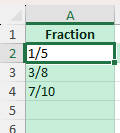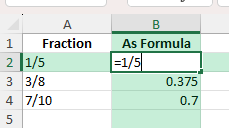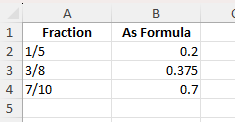Working with fractions in Excel is common, especially in tasks related to measurements, finance, or data analysis. Knowing how to convert a fraction like 1/5 into its decimal form can help you perform further calculations, create accurate reports, or format your data consistently. In Excel, this conversion is straightforward and can be done using several methods depending on your needs.
Key Takeaways
- 1/5 in decimal form is 0.2.
- You can type fractions directly into a cell and format them as decimals.
- The formula
=1/5instantly returns 0.2 in Excel. - Excel’s Fraction and Number formats control how fractions are displayed.
- You can use VBA to automate fraction-to-decimal conversions for multiple cells.
Table of Contents
Understanding Fractions and Decimals in Excel
Excel treats fractions either as text or as numerical values depending on how you enter them. If you type 1/5 into a cell, Excel might interpret it as a date unless you format the cell as a fraction first. However, if you enter it as a formula (=1/5), Excel calculates it as a division problem and returns the decimal result of 0.2.
Why Convert Fractions to Decimals in Excel?
Simplifying Data Presentation
Converting fractions like 1/5 to decimals in Excel significantly simplifies data presentation. It ensures a cleaner spreadsheet appearance which aids in readability and reduces misunderstandings. When dealing with long lists of data, decimals provide consistency that expedites analysis and comparison, especially for users unfamiliar with fractions. Using decimals enhances your ability to create coherent charts and graphs that streamline communication among team members or stakeholders.
Enhancing Precision and Clarity
Converting fractions to decimals enhances both precision and clarity in Excel. Decimals eliminate ambiguities that might arise from fraction representations, especially in computations requiring exact figures. For instance, 1/5 translates to 0.2, which can be crucial for precise data-driven decisions. This approach facilitates more accurate calculations and data interpretation, essential for making well-informed conclusions and minimizing costly errors.
Step-by-Step: Converting 1/5 to a Decimal
Using a Formula
Click on an empty cell (e.g., A1).
Type =1/5.
Press Enter. The result will be 0.2.
Common Mistakes or Tips
Excel reading as a date: Typing 1/5 without formatting might result in January 5 being displayed. Use =1/5 or format as Fraction first.
Extra decimal places: If you see 0.200000, adjust the number of decimal places in Format Cells.
Text values: Fractions stored as text cannot be used in calculations until converted with VALUE().
Bonus Tips
Convert multiple fractions at once: Select the range, then apply the Number format.
Power Query: Load fraction data and use a column transform to perform the division for all rows.
VBA Macro: Use a macro to loop through cells and replace fractions with their decimal equivalent automatically.
Handling Repeating Decimals
Handling repeating decimals in Excel can sometimes be tricky, but it’s essential for maintaining accurate data records. When a fraction converts into a repeating decimal, such as 1/3 becoming 0.3333…, Excel provides options for handling these scenarios. You can determine the number of decimal places to display by formatting cells for a more accurate representation. Additionally, using Excel’s ROUND function helps in rounding these numbers to a fixed number of decimal places, making the data manageable and consistent.
Preventing Calculation Errors
Preventing calculation errors in Excel, particularly with fractions and decimals, requires precision in formatting and function usage. Inaccuracies often arise from improper cell formatting, leading to misinterpretation and flawed results. Ensure that cells are consistently formatted to decimals when necessary to avoid unexpected behavior in formulas and functions. Additionally, double-check that Excel’s automatic conversion settings align with your data presentation needs. Implement data validation rules to capture incorrect data entries early on.
FAQ
What is 1/5 as a decimal? 0.2.
Why does Excel turn my fraction into a date? Because it detects a pattern like “1/5” and assumes it is January 5. Change the cell format or enter as a formula.
Can I keep fractions and decimals in the same column? Yes, but for consistency use one format for calculations.
What if I want more decimal places? Format the cell as Number and increase decimal places.
Does this work for other fractions? Yes, replace 1/5 with any other fraction and Excel will calculate the decimal value.
John Michaloudis is a former accountant and finance analyst at General Electric, a Microsoft MVP since 2020, an Amazon #1 bestselling author of 4 Microsoft Excel books and teacher of Microsoft Excel & Office over at his flagship MyExcelOnline Academy Online Course.










